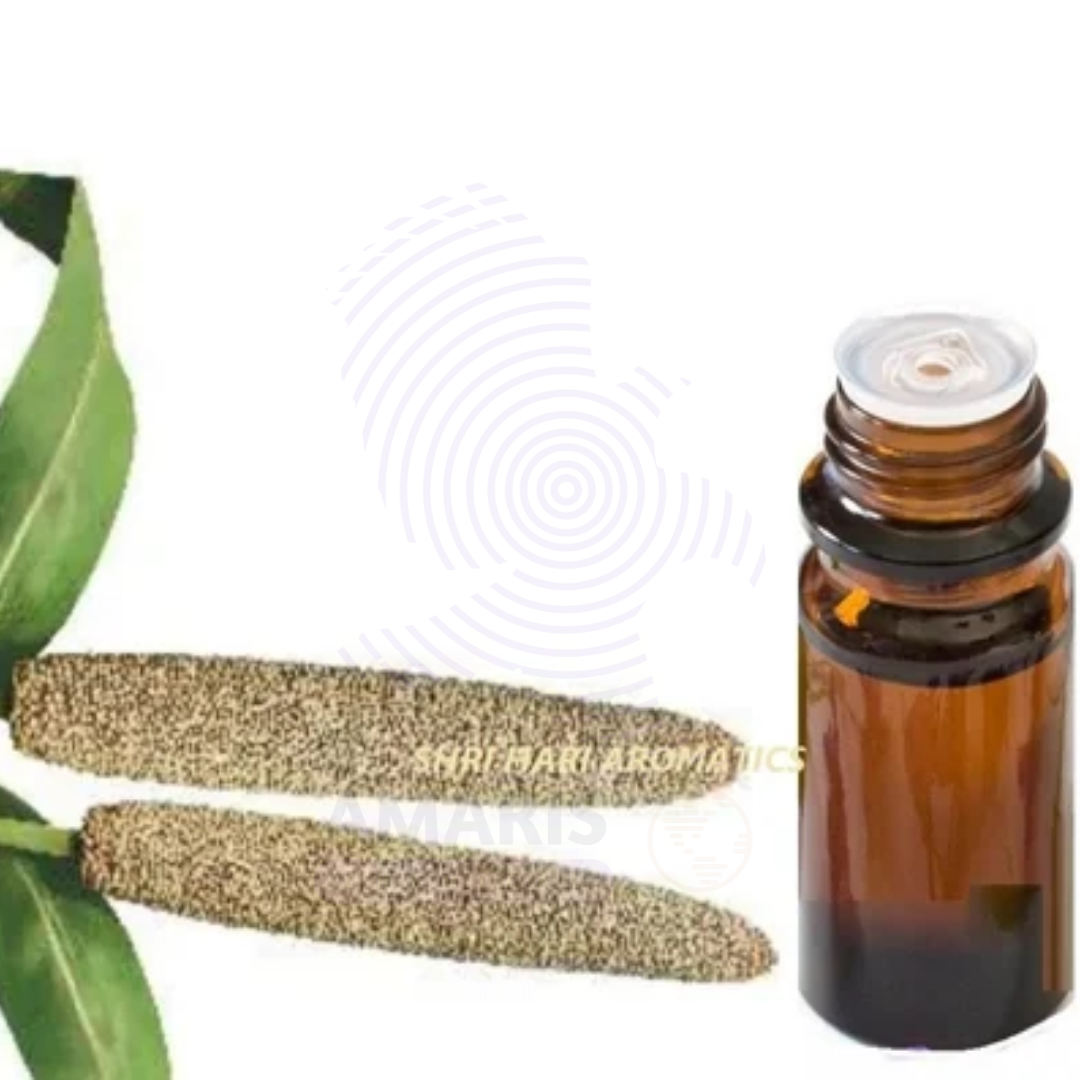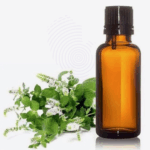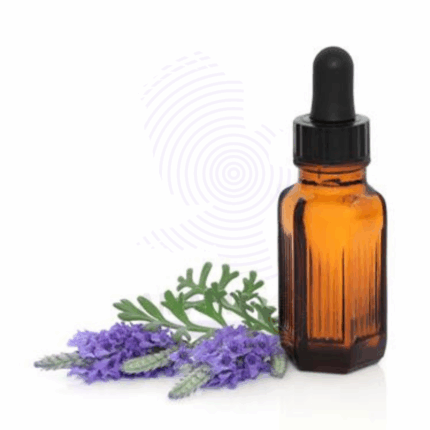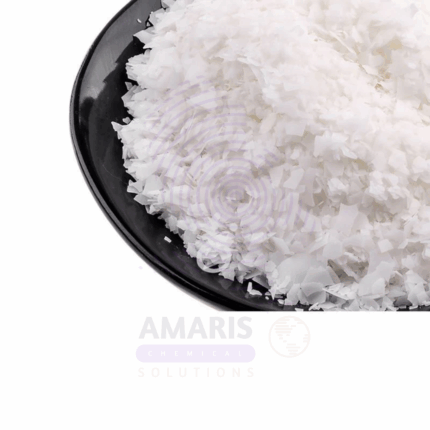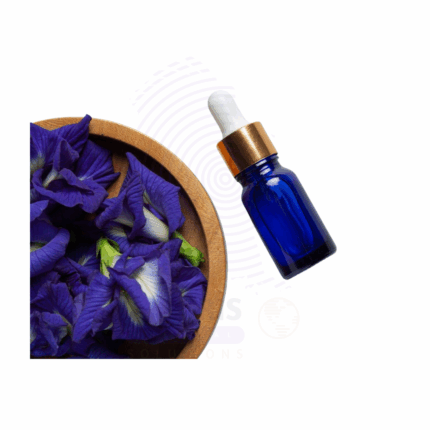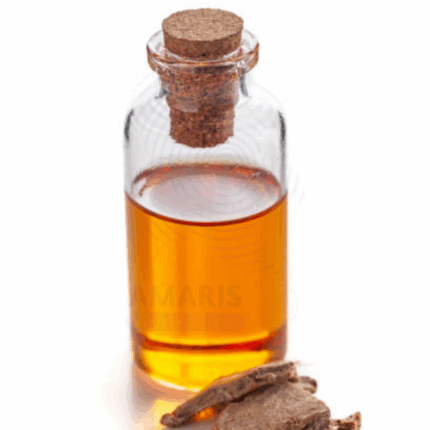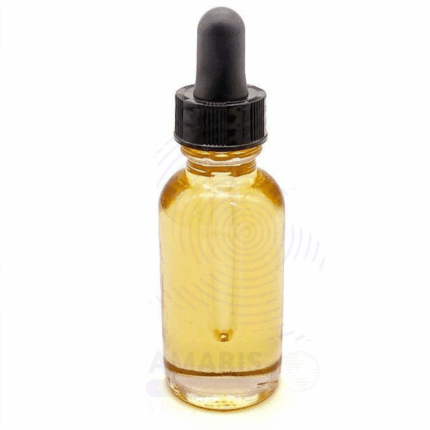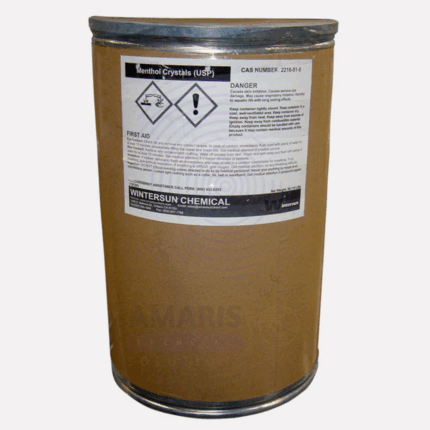Calamus Oil
Calamus Oil is a warm, spicy-aromatic essential oil obtained through steam distillation of the dried roots (rhizomes) of Acorus calamus, commonly known as sweet flag. This highly fragrant oil carries an earthy, woody, and slightly peppery scent with a leathery undertone. Traditionally valued in Ayurvedic and Unani medicine systems, Calamus Oil has found applications in perfumery, hair care, aromatherapy, and natural health preparations due to its stimulating, antimicrobial, and anti-inflammatory properties.
While effective in small external doses, Calamus Oil must be used with caution as it contains β-asarone, a compound restricted in internal use due to potential toxicity. It remains widely used in external formulations like massage oils, hair tonics, and perfumes.
Calamus Oil
Primary Uses
- Cosmetics and Personal Care
- Used in hair oils and scalp tonics to stimulate circulation, reduce dandruff, and support healthy hair growth.
- Included in massage oils and balms for its warming, anti-inflammatory action, especially for joint and muscular pain.
- Incorporated into soaps, bath oils, and skin salves for its deep, grounding scent and antimicrobial properties.
- Utilized in deodorants and foot care products for its antibacterial effects.
- Added to natural toothpaste and mouth rinses (non-ingestible) for traditional oral care.
- Fragrance and Perfumery
- Used as a base note and fixative in perfumes, colognes, and incense due to its persistent, leathery, spicy aroma.
- Common in oriental, woody, and resinous fragrance blends.
- Blended with cedarwood, patchouli, vetiver, and clove oils in natural perfumery.
- Aromatherapy (Cautious Use)
- Applied externally in diluted form to relieve mental fatigue and boost clarity and focus.
- Used in grounding blends for calming the mind and supporting meditation practices.
Secondary Uses
- Traditional Medicine & Herbal Applications
- Historically used topically in poultices and oils for neuralgia, arthritis, and digestive discomfort (external use only).
- Used in Ayurvedic and Siddha preparations for skin and hair balance (non-ingestible).
- Natural Insect Repellent
- Occasionally included in natural pest repellent sprays or oils due to its strong aroma.
1. Basic Identification Attributes
- Botanical Source: Acorus calamus
- Common/Trade Name: Calamus Oil
- INCI Name: Acorus Calamus Root Oil
- CAS Number: 8015-79-0
- HS Code: 3301.29
- Synonyms: Sweet Flag Oil, Calami Rhizoma Oil, Vacha Oil
2. Physical & Chemical Properties
- Physical State: Liquid
- Color & Odor: Pale yellow to brown; warm, woody, spicy, slightly peppery aroma
- Solubility: Insoluble in water; soluble in alcohol and fixed oils
- Main Components: β-Asarone (varies), α-asarone, shyobunone, eugenol
- Refractive Index: 1.500 – 1.540
- Specific Gravity: 0.960 – 1.020
3. Safety & Hazard Attributes
- GHS Classification: Irritant; toxic if ingested
- Toxicity: Contains β-asarone, restricted for internal use in many countries
- Allergen Information: May cause sensitization in some individuals
- Exposure Limits: For external use only, dilute to ≤ 0.1–0.2% in topical formulations
4. Storage & Handling Attributes
- Storage Conditions: Store tightly sealed in a cool, dark place
- Container Type: Amber glass or aluminum bottles
- Shelf Life: Up to 24 months when stored properly
- Handling Precautions: Do not ingest; avoid prolonged skin contact or use on broken skin
5. Regulatory & Compliance Attributes
- Not permitted for internal use in the US and EU due to β-asarone content
- External use permitted under cosmetic regulations when properly diluted
- Use restricted or regulated in several markets; compliance with IFRA guidelines required
6. Environmental & Health Impact
- Biodegradability: Biodegradable
- Ecotoxicity: Low when used responsibly
- Bioaccumulation: Not expected in typical cosmetic concentrations
Safety Handling Precautions
- PPE Required: Gloves and goggles for bulk handling
- Handling Guidelines: Avoid ingestion or undiluted skin application; keep away from children and pets
First Aid Measures
- Inhalation: Move to fresh air if irritation occurs
- Skin Contact: Rinse with soap and water if redness or irritation develops
- Eye Contact: Flush immediately with water for at least 15 minutes
- Ingestion: Do not induce vomiting; seek medical assistance immediately
Firefighting Measures
- Fire Hazards: Flammable oil
- Extinguishing Media: Dry chemical, foam, or CO₂
- Special Precautions: Use protective gear in enclosed areas
- Hazardous Combustion Products: Carbon oxides, aromatic compounds


 Preservatives(food)
Preservatives(food) Flavor Enhancers
Flavor Enhancers Acidulants
Acidulants Sweeteners
Sweeteners Antioxidants
Antioxidants Colorants(food)
Colorants(food) Nutraceutical Ingredients (food)
Nutraceutical Ingredients (food) Nutrient Supplements
Nutrient Supplements Emulsifiers
Emulsifiers
 Collectors
Collectors Dust Suppressants
Dust Suppressants Explosives and Blasting Agents
Explosives and Blasting Agents Flocculants and Coagulants
Flocculants and Coagulants Frothers
Frothers Leaching Agents
Leaching Agents pH Modifiers
pH Modifiers Precious Metal Extraction Agents
Precious Metal Extraction Agents
 Antioxidants(plastic)
Antioxidants(plastic) Colorants (Pigments, Dyes)
Colorants (Pigments, Dyes) Fillers and Reinforcements
Fillers and Reinforcements Flame Retardants
Flame Retardants Monomers
Monomers Plasticizers
Plasticizers Polymerization Initiators
Polymerization Initiators Stabilizers (UV, Heat)
Stabilizers (UV, Heat)
 Antifoaming Agents
Antifoaming Agents Chelating Agents
Chelating Agents Coagulants and Flocculants
Coagulants and Flocculants Corrosion Inhibitors
Corrosion Inhibitors Disinfectants and Biocides
Disinfectants and Biocides Oxidizing Agents
Oxidizing Agents pH Adjusters
pH Adjusters Scale Inhibitors( water)
Scale Inhibitors( water)
 Antioxidants(cosmetic)
Antioxidants(cosmetic) Emollients
Emollients Fragrances and Essential Oils
Fragrances and Essential Oils Humectants
Humectants Preservatives
Preservatives Surfactants(cosmetic)
Surfactants(cosmetic) Thickeners
Thickeners UV Filters
UV Filters
 Fertilizers
Fertilizers Soil Conditioners
Soil Conditioners Plant Growth Regulators
Plant Growth Regulators Animal Feed Additives
Animal Feed Additives Biostimulants
Biostimulants Pesticides (Herbicides, Insecticides, Fungicides)
Pesticides (Herbicides, Insecticides, Fungicides)
 Active Pharmaceutical Ingredients (APIs)
Active Pharmaceutical Ingredients (APIs) Excipients
Excipients Solvents(pharmaceutical)
Solvents(pharmaceutical) Antibiotics
Antibiotics Antiseptics and Disinfectants
Antiseptics and Disinfectants Vaccine Adjuvants
Vaccine Adjuvants Nutraceutical Ingredients (pharmaceutical)
Nutraceutical Ingredients (pharmaceutical) Analgesics & Antipyretics
Analgesics & Antipyretics
 Analytical Reagents
Analytical Reagents Solvents(lab)
Solvents(lab) Chromatography Chemicals
Chromatography Chemicals Spectroscopy Reagents
Spectroscopy Reagents microbiology-and-cell-culture-reagents
microbiology-and-cell-culture-reagents Molecular Biology Reagents
Molecular Biology Reagents Biochemical Reagents
Biochemical Reagents Inorganic and Organic Standards
Inorganic and Organic Standards Laboratory Safety Chemicals
Laboratory Safety Chemicals Specialty Laboratory Chemicals(Special Laboratory Equipment)
Specialty Laboratory Chemicals(Special Laboratory Equipment)
 Demulsifiers
Demulsifiers Hydraulic Fracturing Fluids
Hydraulic Fracturing Fluids Scale Inhibitors(oil)
Scale Inhibitors(oil) Surfactants(oil)
Surfactants(oil) Drilling Fluids
Drilling Fluids
 Dyes and Pigments
Dyes and Pigments Bleaching Agents
Bleaching Agents Softening Agents
Softening Agents Finishing Agents
Finishing Agents Antistatic Agents
Antistatic Agents
 Admixtures
Admixtures Waterproofing Agents
Waterproofing Agents Sealants and Adhesives
Sealants and Adhesives Curing Compounds
Curing Compounds Concrete Repair Chemicals
Concrete Repair Chemicals Anti-Corrosion Coatings
Anti-Corrosion Coatings
 Surfactants(cleaning)
Surfactants(cleaning) Builders
Builders Enzymes
Enzymes Solvents (Cleaning)
Solvents (Cleaning) Fragrances
Fragrances
 Electronic Chemicals
Electronic Chemicals Catalysts
Catalysts Lubricants
Lubricants Photographic Chemicals
Photographic Chemicals Refrigerants
Refrigerants Automotive chemicals
Automotive chemicals Pyrotechnic Chemicals
Pyrotechnic Chemicals
 Biodegradable Surfactants
Biodegradable Surfactants Bio-based Solvents
Bio-based Solvents Renewable Polymers
Renewable Polymers Carbon Capture Chemicals
Carbon Capture Chemicals Wastewater Treatment Chemicals
Wastewater Treatment Chemicals
 Pigments
Pigments Solvents(paint)
Solvents(paint) Specialty Coatings
Specialty Coatings Binders/Resins
Binders/Resins Additives
Additives Driers
Driers Anti-Corrosion Agents
Anti-Corrosion Agents Functional Coatings
Functional Coatings Application-Specific Coatings
Application-Specific Coatings
 Fresh Herbs
Fresh Herbs Ground Spices
Ground Spices Whole Spices
Whole Spices Spice Blends
Spice Blends Dried Herbs
Dried Herbs
 Leavening Agents
Leavening Agents Dough Conditioners
Dough Conditioners Flour Treatments
Flour Treatments Fat Replacers
Fat Replacers Decoratives
Decoratives Preservatives(baking)
Preservatives(baking)
 Plasticizers & Softeners
Plasticizers & Softeners Reinforcing Agents
Reinforcing Agents Adhesion Promoters
Adhesion Promoters Vulcanizing Agents
Vulcanizing Agents Antidegradants
Antidegradants Blowing Agents
Blowing Agents Fillers & Extenders
Fillers & Extenders Accelerators & Retarders
Accelerators & Retarders